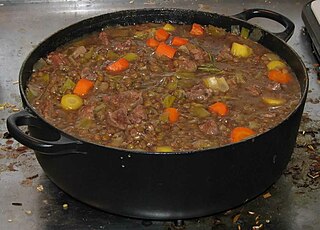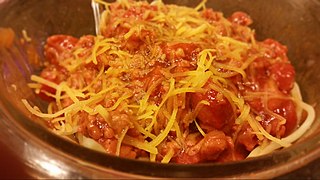
Tripe is a type of edible lining from the stomachs of various farm animals. Most tripe is from cattle and sheep.

In Mexican cuisine, Menudo, also known as pancita or mole de panza, is a traditional Mexican soup, made with cow's stomach (tripe) in broth with a red chili pepper base. Hominy, lime, onions, and oregano are used to season the broth.

Filipino cuisine is composed of the cuisines of more than a hundred distinct ethno-linguistic groups found throughout the Philippine archipelago. However, a majority of mainstream Filipino dishes that compose Filipino cuisine are from the cuisines of the various ethnolinguistic groups and tribes of the archipelago, including the Ilocano, Pangasinan, Kapampangan, Tagalog, Bicolano, Visayan, Chavacano and Maranao ethno-linguistic groups. The style of food making and the food associated with it have evolved over many centuries from their Austronesian origins to a mixed cuisine of Indian, Chinese, Spanish and American influences, in line with the major waves of influence that had enriched the cultures of the archipelago, as well as others adapted to indigenous ingredients and the local palate.

Sinigang is a Filipino soup or stew characterized by its sour and savoury taste. It is most often associated with tamarind, although it can use other sour fruits and leaves as the souring agent. It is one of the more popular dishes in Filipino cuisine.

Tinola is a Filipino chicken soup usually served as an appetizer or a main entrée with white rice. Traditionally, this dish is cooked with chicken, wedges of green papaya, and leaves of the siling labuyo chili pepper in broth flavored with ginger, onions and fish sauce.

The generic term for condiments in the Filipino cuisine is sawsawan. Unlike sauces in other Southeast Asian regions, most sawsawan are not prepared beforehand, but are assembled on the table according to the preferences of the diner.

Babi panggang refers to a variety of recipes for Indonesian grilled pork recipes, 'babi' meaning pig or pork, and 'panggang' meaning grilled or roasted in the Indonesian language.

Kaldereta or caldereta is a goat meat stew from the Philippines. Variations of the dish use beef, chicken, or pork.

Inihaw, also known as sinugba or inasal, are various types of grilled or spit-roasted barbecue dishes from the Philippines. It is usually made from pork or chicken and are served on bamboo skewers or in small cubes with a soy sauce and vinegar-based dip. It can also refer to any meat or seafood dish cooked and served in a similar way. Inihaw are commonly sold as street food and are eaten with white rice or rice cooked in coconut leaves (pusô). Inihaw is sometimes referred to as Filipino barbecue or (informally) Pinoy BBQ.

Menudo, also known as ginamay, is a traditional stew from the Philippines made with pork and sliced liver in tomato sauce with carrots and potatoes. Unlike the Mexican dish of the same name, it does not use tripe or red chili sauce.

Paksiw is a Filipino style of cooking, whose name means "to cook and simmer in vinegar." Common dishes bearing the term, however, can vary substantially depending on what is being cooked.

Hot and sour soup is a soup from Asian culinary traditions. In all cases, the soup contains ingredients to make it both spicy and sour.

A stew is a combination of solid food ingredients that have been cooked in liquid and served in the resultant gravy. Ingredients in a stew can include any combination of vegetables and may include meat, especially tougher meats suitable for slow-cooking, such as beef, poultry, sausages, and seafood. While water can be used as the stew-cooking liquid, stock is also common. A small amount of red wine is sometimes added for flavour. Seasoning and flavourings may also be added. Stews are typically cooked at a relatively low temperature, allowing flavours to mingle.

Embutido or embotido, is a Philippine meatloaf made with ground pork and stuffed with hard-boiled eggs and sliced ham or various sausages. It is traditionally wrapped in aluminum foil and steamed, though it can also be baked.

Afritada is a Spanish based Filipino dish consisting of chicken, beef, or pork braised in tomato sauce with carrots, potatoes, and red and green bell peppers. It is served on white rice and is a common everyday Filipino meal. It can also be used to cook seafood.

Ginataang kalabasa, also known as kalabasa sa gata, is a Filipino vegetable stew made from calabaza in coconut milk and spices. It commonly includes shrimp and yardlong beans and either bagoong or patis. It can also be cooked with fish, crab, or meat and a variety of other ingredients. It is a creamy umami-laden dish that is naturally slightly sweet due to the calabaza. It is a type of ginataan.

Filipino spaghetti is a Filipino adaptation of the Italian spaghetti with Bolognese sauce. It has a distinctively sweet sauce, usually made from tomato sauce sweetened with brown sugar or banana ketchup. It is typically topped with sliced hotdogs or smoked longganisa sausages, giniling, and grated cheese. It is regarded as a comfort food in Philippine cuisine. It is typically served in almost any special occasion, especially on children's birthdays.

Philippine asado refers to two different Filipino braised meat dishes. The name originates from Spanish asado ("grilled"), a reference to the original dish it was applied to, the Chinese-Filipino version of char siu barbecues usually known as pork asado. However, the Filipino versions have evolved to be braised, not grilled. The other Filipino dish also known as asado is asado de carajay. Unlike the Chinese-derived version, it is savory rather than sweet.

Ginataang ampalaya, is a Filipino vegetable stew made from bitter melon and tinapa in coconut milk, bagoong alamang, and spices. The dish can also be made with pork or shrimp and other vegetables. The dish is characteristically savory and slightly bitter due to the ingredients used. It is a type of ginataan.
Everlasting, also known as the Marikina meatloaf, is a Filipino steamed meatloaf originating from Marikina City. It is made with ground pork, Chorizo de Bilbao sausages, carrots, bell peppers, raisins, pickle relish, tomatoes, onions, and eggs. It is similar to the hardinera meatloaf of Quezon and is also traditionally steamed in an oval-shaped tin mold known as a llanera.



















